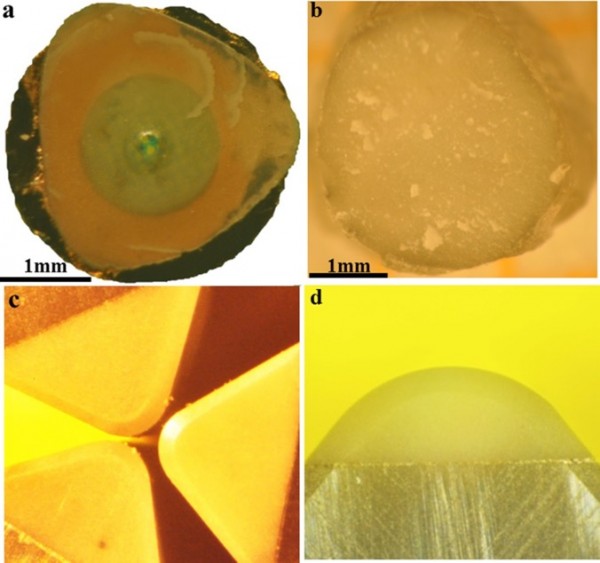Half Diamond, Half Cubic Boron, All Cutting Business

D. W. He/SCU a and b: Bulk diamond-cBN alloy samples synthesized at 20 GPa/2200 °C with a diameter of ~3 mm, over a copper screen to exhibit its transparency c and d: Polished rake faces of diamond-cBN alloy cutters.
Diamonds are forever, except when they oxidize while cutting through iron, cobalt, nickel, chromium, or vanadium at high temperatures. Conversely, cubic boron nitride possesses superior chemical inertness but only about half of the hardness of diamonds.
In an attempt to create a superhard material better suited for a wide variety of materials on an industrial scale, researchers at Sichuan University in Chengdu, China, have created an alloy composed of diamonds and cubic boron nitride (cBN) that boasts the benefits of both.
“Diamond and cubic boron nitride could readily form alloys that can potentially fill the performance gap because of their affinity in structure lattices and covalent bonding character,” said Duanwei He, a professor at Sichauan University's Institute of Atomic and Molecular Physics. “However, the idea has never been demonstrated because samples obtained in previous studies are too small to test their practical performance.”
He and his colleagues at the University of Nevada and the Chinese Academy of Sciences detail their procedure this week in Applied Physics Letters, from AIP Publishing.
To synthesize diamond-cBN alloys, the researchers subjected a homogenous mixture of diamond and cubic boron nitride powder to a vacuum furnace at 1300 K for two hours, then pressed the material into 3.5 millimeter pellets under pressure greater than 15 gigapascals and temperatures above 2000 K. The pellets were then polished and sharpened into cutting implements.
The researchers tested the cutting performances of their alloy on hardened steel and granite bars on a computer numerical controlled lathe. They found that the diamond-cBN alloy rivaled polycrystalline cubic boron nitride's wear and tool life on the steel samples, and exhibited significantly less wear when cutting through granite. The alloy also demonstrated a more preferable high-speed cutting performance than either polycrystalline CBN or commercial polycrystalline diamonds.
Future work for He and his colleagues involves developing synthesis technology for centimeter-sized diamond-cBN alloy bulks to bring the process up to industrial-scale production.
The article, “Diamond-cBN Alloy: a Universal Cutting Method” is authored by Pei Wang, Duanwei He, Liping Wang, Zili Kou, Yong Li, Lun Xiong, Qiwei Hu, Chao Xu, Li Lei, Qiming Wang, Jing Liu, and Yusheng Zhao. It will appear in the journal Applied Physics Letters on September 8, 2015 (DOI: 10.1063/1.4929728). After that date, it can be accessed at: http://scitation.aip.org/content/aip/journal/apl/107/10/10.1063/1.4929728
ABOUT THE JOURNAL
Applied Physics Letters features concise, rapid reports on significant new findings in applied physics. The journal covers new experimental and theoretical research on applications of physics phenomena related to all branches of science, engineering, and modern technology.
http://apl.aip.org
Contact Information
Jason Socrates Bardi
+1 240-535-4954
jbardi@aip.org
@jasonbardi
Media Contact
All latest news from the category: Materials Sciences
Materials management deals with the research, development, manufacturing and processing of raw and industrial materials. Key aspects here are biological and medical issues, which play an increasingly important role in this field.
innovations-report offers in-depth articles related to the development and application of materials and the structure and properties of new materials.
Newest articles

Recovering phosphorus from sewage sludge ash
Chemical and heat treatment of sewage sludge can recover phosphorus in a process that could help address the problem of diminishing supplies of phosphorus ores. Valuable supplies of phosphorus could…

Efficient, sustainable and cost-effective hybrid energy storage system for modern power grids
EU project HyFlow: Over three years of research, the consortium of the EU project HyFlow has successfully developed a highly efficient, sustainable, and cost-effective hybrid energy storage system (HESS) that…

After 25 years, researchers uncover genetic cause of rare neurological disease
Some families call it a trial of faith. Others just call it a curse. The progressive neurological disease known as spinocerebellar ataxia 4 (SCA4) is a rare condition, but its…





















